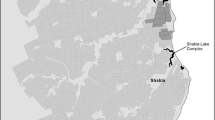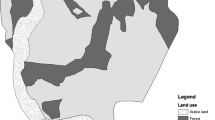Abstract
The grey partridge Perdix perdix is of conservation concern owing to habitat heterogeneity losses and the negative impact of other environmental factors, e.g., pesticide use, predators, weather or shooting pressure, which are known to be associated with population decline. By an 11-year-period study in an intensively cultivated farmland located in the Paris basin, we aimed to relate the changes in grey partridge population dynamics with the changes in agriculture, monthly rainfall and shooting pressure. Summer drought occurred at the middle time of the study period. At the start of our study, a new cultivation, winter-wheat broadcast in maize-stubble fields, was introduced that probably improved the habitat. But in the next years, there was a loss in habitat diversity due to the disappearance of pastures dedicated to sheep rearing, removal of non-cropped areas and field boundaries and increase in the mean field size. Shooting was annually adjusted to what the owner believed to be a wise harvest. In post-breeding coveys, both percentages of hens with young among total hens and young-to-successful hens ratios first increased and then decreased. The mean brood size was rather weak during the dryness incident. The number of pairs in a more heterogeneous sector was always greater than in a less one. In both sectors, spring abundance first increased and then decreased. In the second half of the study period, the shooting quotas were reduced, especially when the mean brood size fell down. Low hatching rates of clutches and low chick survival rates explain the population decline, as the results are convincing. To stop the population decline in intensive arable farmland, good breeding success is needed. This can be provided by favourable habitats for hens to nest and for chicks to feed.




Similar content being viewed by others
References
Aebischer NJ (1991) Sustainable yields: gamebirds as a harvestable resource. Gibier Faune Sauvage 8:335–351
Aebischer NJ, Ewald J (2004) Managing the UK Grey Partridge Perdix perdix recovery: population change, reproduction, habitat and shooting. Ibis 146(Suppl. 2):181–191
Benton TG, Bryant DM, Cole L, Crick HQP (2002) Linking agricultural practice to insect and bird populations: a historical study over three decades. J Appl Ecol 39:673–687
Benton TG, Vickery JA, Wilson JD (2003) Farmland biodiversity: is habitat heterogeneity the key? Trends Ecol Evol 18:182–188
Birkan MG (1977a) Population de Perdrix grise (Perdix perdix L.) et agriculture: une étude sur un territoire de chasse près de Provins. In: Pesson P, Birkan MG (eds), Ecologie du petit gibier et aménagement des chasses. Gauthier-villars, Paris, pp 137–159
Birkan MG (1977b) Analyse des tableaux de chasse de Perdix (Perdix perdix L. et Alectoris rufa L.). Courbes d’éclosion, structure et dynamique des populations, plan de chasse. In: Pesson P, Birkan MG (eds), Ecologie du petit gibier et aménagement des chasses, Gauthier-villars, Paris, pp 55–77
Birkan M (1979) Perdrix grises et rouges de chasse et d’élevage. La Maison Rustique, Paris
Birkan M (1985) Dynamique de population et relation avec l’occupation du milieu par la Perdrix grise (Perdix perdix). In: de Crombrugghe SA (ed), Transactions of the XVIIth Congress of the International Union of Game Biologists. Ministery of Agriculture, Agricultural Research Administration, Brussels (Belgium), pp 927–934
Birkan M, Jacob M (1988) La Perdix Grise. Hatier, Paris
Blank TH, Southwood TRE, Cross DR (1967) The ecology of the grey partridge. I. Outline of population processes with particular reference to chick mortality and nest density. J Anim Ecol 36:549–556
Bradbury RB, Browne SJ, Stevens DK, Aebischer NJ (2004) Five-year evaluation of the impact of the Arable Stewardship Pilot Scheme on birds. Ibis 146(Suppl. 2):171–180
Bro E, Sarrazin F, Clobert J, Reitz F (2000) Demography and the decline of the grey partridge Perdix perdix in France. J Appl Ecol 37:432–448
Bro E, Reitz F, Clobert J, Migot P, Massot M (2001) Diagnosing the environmental causes of decline in Grey Partridge Perdix perdix survival in France. Ibis 143:120–132
Bro E, Mayot P, Corda E, Reitz F (2004) Impact of habitat management on grey partridge populations: assessing wildlife cover using a multisite BACI experiment. J Appl Ecol 41:846–857
Chamberlain DE, Fuller RJ (2001) Contrasting patterns of change in the distribution and abundance of farmland birds in relation to farming system in lowland Britain. Global Ecol Biog 10:399–409
Cramp S, Simmons KEL (1980) The Birds of the Western Palearctic. 2: Hawks to Bustard. Oxford University Press, Oxford
Evans KL (2004) The potential for interactions between predation and habitat change to cause population declines of farmland birds. Ibis 146:1–13
Green RE (1984) The feeding ecology and survival of partridge chicks (Alectoris rufa and Perdix perdix) on arable farmland in East Englia. J Appl Ecol 21:817–830
Moorcroft D, Whittingham MJ, Bradbury RB, Wilson JD (2002) The selection of stubble fields by wintering granivorous birds reflects vegetation cover and food abundance. J Appl Ecol 39:535–547
Newton I (2004) The recent declines of farmland bird populations in Britain: an appraisal of causal factors and conservation actions. Ibis 146:579–600
Olivier J, Birkan MG, Aubineau J (1977) Effets d’aménagements du milieu agricole sur les populations de perdrix grise d’un territoire de chasse du Soissonnais. In: Pesson P, Birkan MG (eds), Ecologie du petit gibier et aménagement des chasses. Gauthier-villars, Paris, pp 161–192
Panek M (1992) The effect of environmental factors on survival of grey partridge (Perdix perdix) chicks in Poland during 1987–89. J Appl Ecol 29:745–750
Pépin D, Angibault JM (2007) Selection of resting sites by the European hare as related to habitat characteristics during agricultural changes. Eur J Wildl Res 53:183–189. DOI 10.1007/s10344-007-0087-1
Potts GR (1980) The effects of modern agriculture, nest predation and game management on the population ecology of partridges (Perdix perdix and Alectoris rufa). Adv Ecol Res 11:1–79
Potts GR, Aebischer NJ (1995) Population dynamics of the grey partridge Perdix perdix 1793–1993: monitoring, modelling and management. Ibis 137:S29–S37
Rands MRW (1985) Pesticide use on cereals and the survival of partridge chicks: a field experiment. J Appl Ecol 22:49–54
Reitz F (2003) La gestion quantitative des perdrix grises en plaine. Faune Sauvage 260:14–20
Robinson RA, Sutherland WJ (2002) Post-war changes in arable farming and biodiversity in Great Britain. J Appl Ecol 39:157–167
Serre D, Birkan M (1985) Incidence de traitements insecticides sur les ressources alimentaires de poussins de perdrix grise. Gibier Faune Sauvage 4:21–61
Southwood TRE, Cross DJ (1969) The ecology of the partridge. III. Breeding success and the abundance of insects in natural habitats. J Anim Ecol 38:497–509
Siriwardena GM, Baillie SR, Buckland ST, Fewster RM, Marchant JH, Wilson JD (1998) Trends in the abundance of farmland birds: a quantitative comparison of smoothed Common Birds Census indices. J Appl Ecol 35:24–43
Stoate C, Henderson IG, Parish DMB (2004) Development of an agri-environment scheme option: seed-bearing crops for farmland birds. Ibis 146(Suppl. 2):203–209
Strijker D (2005) Marginal lands in Europe—causes of decline. Basic Appl Ecol 6:99–106
Tapper SC, Potts GR, Brockless MH (1996) The effect of an experimental reduction in predation pressure on the breeding success and population density of grey partridges Perdix perdix. J Appl Ecol 33:965–978
The Game Conservancy Trust. 2006. The grey partridge—Grey partridge and shooting. http://gct.org.uk/greypartridge/shooting.html.
Wilson JD, Whittingham MJ, Bradbury RB (2005) The management of crop structure: a general approach to reversing the impacts of agricultural intensification on birds? Ibis 147:453–463
Acknowledgements
Financial support for this study was provided by the National Institute of Agronomic Research (Institut National de la Recherche Agronomique). We are grateful to Mr Henri de Boisgelin and to the farmers for permitting us to work in their properties and to sex and age the birds during autumn counts and shooting. We are very grateful to the volunteers who helped us to carry out the spring censuses. Finally, we are indebted to reviewers for very constructive comments.
Author information
Authors and Affiliations
Corresponding author
Additional information
Communicated by W. Lutz
Rights and permissions
About this article
Cite this article
Pépin, D., Birkan, M. & Angibault, JM. Factors affecting changes in grey partridge population dynamics in a French arable farmland over an eleven-year period. Eur J Wildl Res 54, 179–187 (2008). https://doi.org/10.1007/s10344-007-0125-z
Received:
Revised:
Accepted:
Published:
Issue Date:
DOI: https://doi.org/10.1007/s10344-007-0125-z




